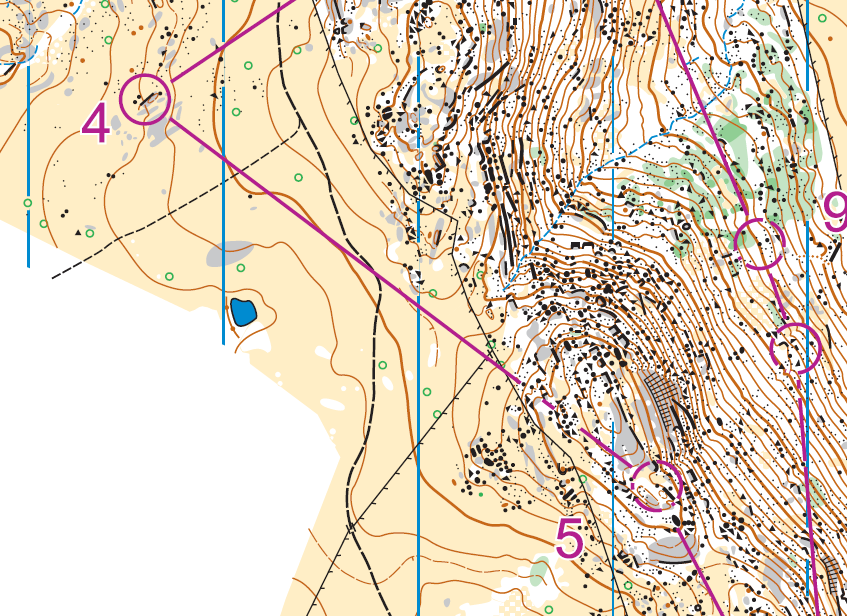Intermediate Orienteering Skills
Lesson 12: Plans, Route Choice and ‘Traffic Light’ Orienteering
The Plan
Before leaving the start triangle or any control, you must orientate your map and make a simple plan which contains a ‘strong’ attack point. When possible, use line features (or handrails) to make the navigation simpler and safer. You might also pick out some distinct features along the leg that help simplify navigation, such as a saddle, large cliff or watercourse intersection.
If there is no obvious attack point, or the control is in the middle of complex detail (such as gold mining or complex granite rock) or is in a vague area with low visibility green, you will need to slow down and approach the control very carefully.
Once you have made up a plan, make certain you execute the plan exactly, and don’t be tempted to cut any corners. Make certain you arrive at your attack point, and take the final approach carefully.
The plan for each leg should simplify the navigation by picking out the large, easy-to-follow features. This allows you to speed up and makes the navigation easier. However, this does not mean that you ignore all the other detail. This extra detail is crucial because it allows you to keep exactly on line (and hence save time) and if you constantly check it, there’s much less chance of losing contact with the map.
Route Choice
More often than not, there will be a choice of different routes between controls and the competitor must evaluate which route is the best. This will involve trade-offs between a number of factors including ‘distance’, amount of ‘climb’, ‘thickness of the forest’ and ‘tracks versus terrain’. For instance, is it better to run over a hill (more climb) or around it (less climb but more distance).
As a general rule, route choice is more important for long legs and less important for short legs. So, if you are faced with a very long leg that has numerous possible route choices, it is worth spending some time carefully assessing the different options.
However, the most important consideration is to choose a route that minimises the risk of errors by utilising line features and picking a strong attack point or catching feature. For most orienteers, including elites, more time is lost making navigational errors than from poor route choice.
A British study discovered that a common technique used by elite orienteers was to plan ‘backwards’. They look at the control they are heading towards, and choose a suitable attack point. Then they work backwards, looking for linear features that can lead them in to the attack point. In contrast, novice orienteers tend to plan ‘forwards’, firstly looking for an easy exit then progressively developing a plan that takes them closer and closer to the next control, before thinking about the best way to approach the next control.
Traffic Light Orienteering
If you are going too fast you will make mistakes. It is very important to balance your running speed with the difficulty of the navigation. Many mistakes are made when the orienteer does not adjust running speed to the conditions. Changing speed to suit the navigational difficulty is called ‘traffic light’ orienteering.
For each leg, it is possible to categorise the route into three categories:
‘Green’ is for the parts where you can run confidently along linear features or towards a large catching feature (such as a fence or track) with minimal cross checking.
‘Orange’ is for parts where you are not following linear features and need to slow down and pay more attention to the navigation.
‘Red’ is for parts where you need to go very slowly, possibly walking or stopping regularly to cross-check the map and scan the forest. This might be due to very complex detail, a poor attack point or a control sited in low visibility forest.
Most importantly, only run at a pace where you can cross-check and maintain exact contact. And if you are unsure, stop and check the map. 10 seconds can save 10 minutes!
Competitive orienteering at optimal speed – hints from Oyvin Thon, a former World Champion
Adjust speed to reduce mistakes. One of the most common reasons for making mistakes is that “you didn’t adjust your speed to the conditions”.
Navigate ahead of yourself. Ideally, you should run at a pace where you can be a “that’s where I’m going next” orienteer, instead of “I think that’s where I am” orienteer. The best navigators know what they will be seeing next, before they get there. They navigate ‘ahead’ of themselves, instead of behind.
Rhythm. Don’t run so fast that you can’t keep a good rhythm. In orienteering rhythm is: map reading in front of where you actually are; deciding route choices in advance (big and small route choices); have a prepared “control work” before coming to the control (eg. know your control code, control description, exit direction, etc). If you are losing rhythm you will lose the initiative.
Change speed. Read out of the map that this is a difficult control which I have to attack at a slow pace, and on the other hand understand when it’s needed to run fast. Do not run so fast that you are unable to read the map. And you have to set the pace, so that you can finish the race without getting too tired.
Exercise
On the map below, develop a plan for leg 4) to 5). Then use the concept of ‘traffic light’ orienteering to determine which parts of the leg are ‘green’, ‘orange’ and ‘red’.

